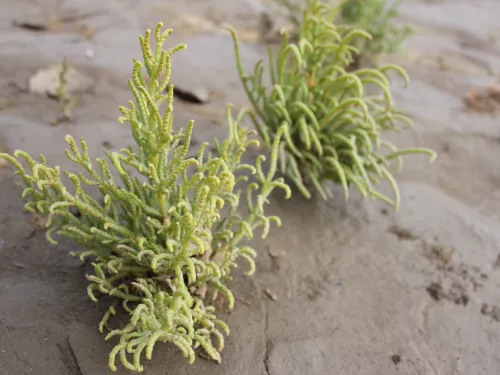
Common glasswort
Sometimes called 'Marsh samphire', wild common glasswort is often gathered and eaten. It grows on saltmarshes and beaches, sometimes forming big, green, fleshy carpets.

Sometimes called 'Marsh samphire', wild common glasswort is often gathered and eaten. It grows on saltmarshes and beaches, sometimes forming big, green, fleshy carpets.
Windy, open moors covered in bright yellow, spiky common gorse bushes and purple heathers are synonymous with what we call 'wild' landscapes, but it can be seen in many habitats, from coast to town.
The Common green grasshopper can be found in damp meadows and woodland rides throughout summer. Males can be seen rubbing their legs against their wings to create a 'song' for the females.
The common green lacewing is a lime green, delicate insect, with translucent, intricately veined wings. It is common in gardens and parks, where it helps to control aphid pests.
The common shieldbug was once restricted to Southern England, but has since been moving northwards and is now quite widespread. It can be found in all kinds of habitats from gardens to farms.
Despite its name, the common gull is not as common as some of our other gulls. It can be spotted breeding at the coast, but is also partial to sports fields, landfill sites and housing estates in winter.
The Common harvestman is familiar to us as the large, spindly spider-like creature that frequents gardens and houses. It predates on smaller invertebrates which it catches using hooks on the ends of its legs.
A large hawker, the Common Hawker can be seen throughout the summer and into autumn. A fast-flying insect, it catches its prey mid-air. Look for it around ponds in the uplands of the north and west.
In May, our hedgerows burst into life as common hawthorn erupts with creamy-white blossom, colouring the landscape and giving this thorny shrub its other name of 'May-tree'.
Mainly found in Southern and Eastern England, the Common hornbeam is a tall tree of ancient woodlands. Its large catkins appear in spring, and its winged seeds are dispersed by the wind in autumn.
A sprawling, spiny evergreen, Common juniper is famous for its traditional role in gin-making. Once common on downland, moorland and coastal heathland, it is now much rarer due to habitat loss.
The tightly packed, thistle-like purple flower heads of common knapweed bloom on all kinds of grasslands. Also regularly called 'black knapweed, this plant attracts clouds of butterflies.